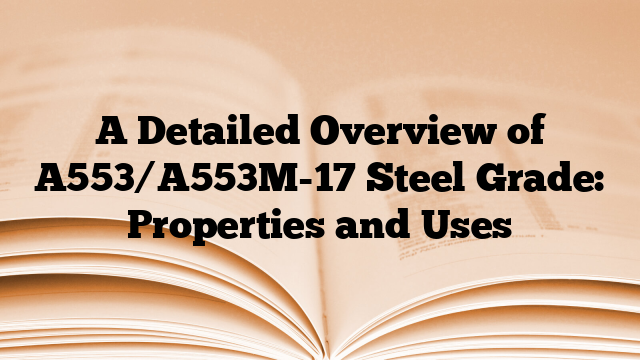The A553/A553M-17 steel grade is a high-strength, low-alloy steel commonly used in pressure vessel applications. It is primarily used for the construction of cryogenic pressure vessels, which are designed to store and transport gases at extremely low temperatures.
Chemical Composition:
The chemical composition of A553/A553M-17 steel grade is as follows:
– Carbon (C): 0.12% maximum
– Manganese (Mn): 0.60-0.90%
– Phosphorus (P): 0.025% maximum
– Sulfur (S): 0.025% maximum
– Silicon (Si): 0.15-0.40%
– Nickel (Ni): 9.00-12.00%
– Molybdenum (Mo): 0.50% maximum
– Chromium (Cr): 0.30% maximum
– Copper (Cu): 0.20% maximum
– Aluminum (Al): 0.01-0.05%
Mechanical Properties:
The mechanical properties of A553/A553M-17 steel grade are as follows:
– Tensile Strength: The minimum tensile strength of this steel grade is 550 MPa (megapascal).
– Yield Strength: The minimum yield strength of A553/A553M-17 steel grade is 450 MPa.
– Elongation: The minimum elongation after fracture for this steel grade is 18%.
– Impact Toughness: A553/A553M-17 steel grade has excellent impact toughness at low temperatures, making it suitable for cryogenic applications.
Standard Number:
The A553/A553M-17 steel grade is defined by the ASTM A553/A553M standard. This standard specifies the requirements for normalized, quenched, and tempered 7% nickel alloy steel plates for pressure vessels.
Corresponding Grades:
The A553/A553M-17 steel grade is similar to other high-strength steel grades used in pressure vessel applications. Some corresponding grades include SA553 Type I, SA553 Type II, and similar grades specified by other standards such as EN 10028-4.
Uses:
Due to its high-strength and excellent low-temperature properties, A553/A553M-17 steel grade is commonly used in the construction of cryogenic pressure vessels, such as liquefied natural gas (LNG) storage tanks and transport vessels. These vessels are required to maintain the extremely low temperatures of liquefied gases for extended periods. A553/A553M-17 steel grade is also suitable for other high-pressure and high-temperature applications, including aerospace and nuclear industries, where high strength and toughness are required.

